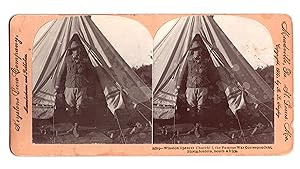Beschreibung
"This stereoscope card is a photographic image of Churchill as a correspondent during the Boer War. It was produced in 1900 by an American manufacturer, the Keystone View Company, as part of their Boer War images series. This stereoscope card is highly prized amongst Churchilliana collectors. It was one of the earliest career images of WSC. Also, while other cards from Keystone's Boer War series are readily available on the open market, it is very difficult to obtain and seldom appears at auction."Condition is very good. The card is complete, the images of Churchill still sharp. We note horizontal cupping and light wear to extremities, as well as light, circular spots, visible across the tent and Churchill s body in the right image, substantially confined to the right side of the tent in the left image."For those unfamiliar with stereoscopes, this was a home entertainment device popular from the 1850's through the 1930's. Similar to a more modern View Master, a two-image card would be inserted into the viewer; though the use of double lenses, the user would see one fused image, complete with a terrific three-dimensional look. Stereoscopes attained their height of popularity in the Victorian ere and were as popular in most living rooms as a piano. Through the use of this device, the user could purchase a series of cards on various topics and be taken instantly to distant areas of the world, explore events reported in the daily newspapers and even see exotic foreign animals and plants. It is fitting, then, that a Boer War series would be published, allowing images of the war in far off South Africa to be viewed in the comfort of one's living room, thousands of miles away."In October 1899, the second Boer War erupted between the descendants of Dutch settlers in South Africa and the British. Churchill, an itinerant, adventure-seeking young cavalry officer and war correspondent, swiftly found himself in South Africa with the 21st Lancers and an assignment as press correspondent to the Morning Post. Not long thereafter, on 15 November 1899, Churchill was captured during a Boer ambush of an armored train. His daring and dramatic escape less than a month later made him a celebrity and helped launch his political career."By the time this stereoscope card was published, Churchill had already attained notoriety for his famous escape from Boer imprisonment in Pretoria. Rather than returning home immediately, Churchill rejoined General Redvers Buller's army on its march to relieve British troops at the Siege of Ladysmith and to retake Pretoria. Although he continued as a war correspondent for The Morning Post with a salary of £250 per month, he also obtained a commission in the South African Light Horse."But the true leverage of Churchill s Boer War experience came on the hustings. Churchill returned from South Africa in July 1900 and spent the summer campaigning hard in Oldham, where he had lost a by-election his first attempt at Parliament in July 1899. Since then, as Arthur Balfour (who became Prime Minister in 1902) put it in a 30 August 1900 letter, the young Churchill had had "fresh opportunities - admirably taken advantage of for shewing the public of what stuff you are made." Churchill won his first seat in Parliament on 1 October 1900 in the so-called "khaki election". He was just 25 years old. While he had proven himself on the battlefield, he had yet to experience either the trying failures or supreme triumphs that cemented his place in history. Ultimately his political career would last two thirds of a century, see him occupy Cabinet office during each of the first six decades of the twentieth century, carry him twice to the premiership and, further still, into the annals of history as a preeminent statesman. When this image of Churchill was captured, all of this lay still before him; he was still just an itinerant Victorian cavalry officer and war correspondent.Reference: Brian Krapf, Chartwell Bulletin #98, August 2016. Bestandsnummer des Verkäufers 007927
Verkäufer kontaktieren
Diesen Artikel melden
![]()
